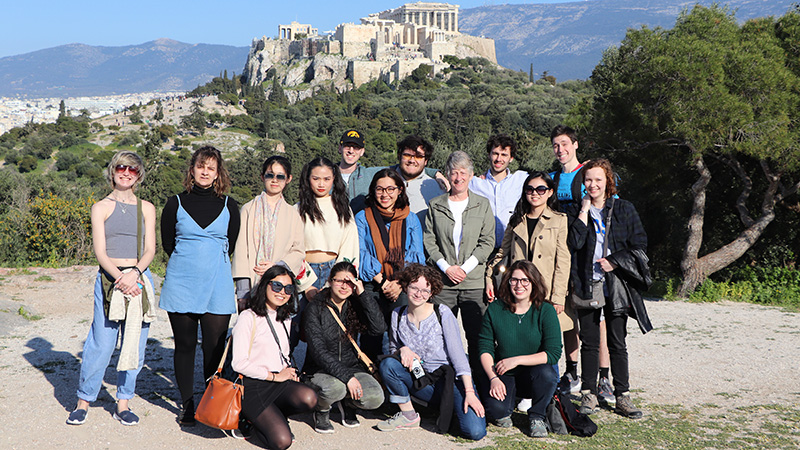Not a simple question
A Grinnell College classics/art history course traveled to London and Greece last spring to explore the nuances surrounding the ownership of Greek antiquities.
Who owns Greek antiquities? It seems like a simple question with a simple answer: Surely the Greeks should. But as the 16 students in the spring 2019 course, Greek Architectural Sculpture: Style, Context, and Ownership, discovered, it’s a complex, international, and emotionally charged issue.
Monessa Cummins, associate professor of classics, and Lesley Wright, director of the Grinnell College Museum of Art, team-taught the classics/art history course. They used the Parthenon sculptures as a case study to examine the ownership issue. Do antiquities belong to the country where the artwork was originally created and displayed? Or the country that has owned the artwork for two centuries and exhibits it in one of its most prestigious museums?
To help students answer those questions, Cummins and Wright thought it was essential to include a travel component in the course. “The real motherlode is seeing the pieces in person,” Cummins says.
 Students traveled to Greece to examine firsthand the complicated question of ownership of Greek antiquities.
Students traveled to Greece to examine firsthand the complicated question of ownership of Greek antiquities.
That way students could experience and analyze the Parthenon sculptures held by the British Museum in London and those held by the Acropolis Museum in Athens. Seeing the artwork in two different contexts would underscore the complexity of the ongoing controversy.
Visiting the British Museum and the Acropolis Museum during the same trip “helped us understand the context of the Parthenon itself and the sculptures,” says Damaris Marquez Membreno ’21, a psychology major from Maryland. It was her first trip abroad.
Another benefit of travel is the access it provides to the scholars working in those places. One of the books the students read for class was written by Ian Jenkins, senior curator with the British Museum’s Department of Greece and Rome. He provided the class a guided tour at the museum and ended up spending two hours with them “because our students were that involved and interested,” Wright says.
A spontaneous, scholar-led tour was provided at the Acropolis Museum by Jenifer Neils, director of the American School of Classical Studies at Athens. Students had read her work too.
“We did not know that this would happen,” Wright says. “I think the fact that we were doing a very serious consideration of a very thorny issue was impressive to people, that a group of American undergraduates were willing to tackle this and not make glib assumptions about what should happen.”
The travel also furthered students’ cultural respect through casual conversations with local people. Maverick Zhang ’20, a classics and biological chemistry double major from China, discussed the issue with a receptionist at the group’s London hotel. “She was born in Greece,” Zhang says. “She felt really strongly about the marbles, even though she grew up in London. I had a sense of how complicated these things can be.”
By the end of the semester, students in the class were evenly divided, for very nuanced reasons, on what should happen to the marbles currently in London. Their conclusion mirrored the sense of the audience who heard their public debate: While three-quarters of the audience voted to return the marbles before the debate started, by the end, after hearing the complexities of the situation, slightly more than half were convinced to leave them in London. Who owns Greek antiquities is anything but simple.
Making the Course and Its Travel Happen
Planning and executing such a course is also anything but simple. The trip was made possible largely through the Elson-McGinty Fund for Classics and the Van Dusen/Spiegel Course-Embedded Travel Fund. These trips are expensive undertakings if you want to do them well, Wright says. Students, however, pay only an extra $400 for the course. Cummins points out that philanthropy also makes the team-teaching possible by providing faculty members the time and intellectual space to design the course and plan the travel.
Impact of Travel Opportunities
Each year 30–65 students are fortunate enough to participate in faculty-led programs like this one. The number of courses offered fluctuates depending on faculty availability, departmental demands, and funding.
The Institute for Global Engagement reports that students who participate in these programs have a 10 percent higher rate of enrolling in additional off-campus experiences.
Clearly, students value and grow from such travel opportunities, as Anne Campbell Spence ’66, a retired trustee who participated in the trip, notes: “Actually being there makes it so much more of a learning experience. I came away very impressed by that group of young people.”
— by Michele Regenold ’89